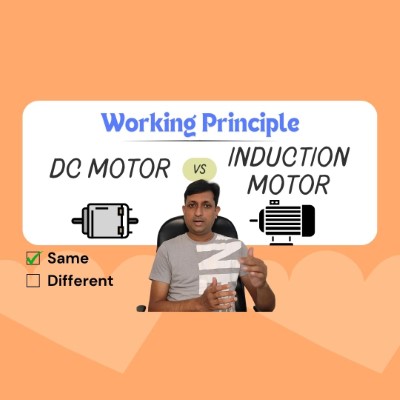Hello and welcome to Tech4Savvy! Today, we’re going to explore whether the working principles of both induction motors and DC motors are the same. Spoiler alert: the answer is yes. Both DC motors and induction motors operate on the same basic principle. Let’s dive deeper into this topic to understand how they work and what differentiates them.
The Fundamental Principle
At the heart of both DC motors and induction motors lies a fundamental principle: when a current-carrying conductor is placed in a magnetic field, it experiences a force. This force acts on the conductor, causing it to move. In both types of motors, this principle is used to generate rotational motion.
DC Motor Working Principle
In a DC motor, the current in the conductor is produced by supplying DC voltage through a commutator. The commutator ensures that the current direction in the coil changes to maintain continuous rotation. Here’s a step-by-step breakdown:
- Current Supply: DC voltage is supplied to the motor.
- Magnetic Field: The magnetic field is produced either by permanent magnets or by energizing the pole shoes to create stationary magnetic poles.
- Force Generation: The current-carrying conductor (armature winding) interacts with the magnetic field, experiencing a force.
- Rotation: This force causes the armature to rotate, which in turn rotates the motor’s shaft.
Induction Motor Working Principle
An induction motor, on the other hand, does not use a direct electrical connection to the rotor. Instead, it relies on electromagnetic induction to generate current in the rotor conductors. Here’s how it works:
- Stator and Rotor Setup: The stator, connected to a three-phase AC supply, creates a rotating magnetic field.
- Electromagnetic Induction: As the rotating magnetic field sweeps past the rotor, it induces an electromotive force (EMF) in the rotor conductors.
- Current Induction: This induced EMF causes a current to flow in the short-circuited rotor conductors.
- Force Generation: The interaction between the induced current in the rotor and the rotating magnetic field produces a force.
- Rotation: This force causes the rotor to rotate, following the rotating magnetic field.
Key Differences
While both motors operate on the same basic principle, the methods of generating current and magnetic fields differ:
- DC Motor:
- Uses a DC supply.
- Magnetic field is generated by permanent magnets or stationary pole shoes.
- Current is supplied directly through a commutator.
- Induction Motor:
- Uses a three-phase AC supply.
- Magnetic field is generated by the stator and is rotating.
- Current is induced in the rotor by the rotating magnetic field.

Additional Motor Types
It’s important to note that not all motors operate on this principle. For example:
- Switched Reluctance Motors: Operate on the principle of reluctance torque.
- Brushless DC Motors (BLDC): Use electronic commutation to control the motor.
- Synchronous Reluctance Motors: Rely on the reluctance of the magnetic path.
Conclusion
In summary, both DC motors and induction motors utilize the principle that a current-carrying conductor placed in a magnetic field experiences a force. However, the way they produce current and magnetic fields is different. Understanding these differences helps in selecting the right motor for the right application.
Thank you for watching! If you found this explanation helpful, please like, comment, and subscribe to Rhyni Tech Skills and Fundamentals for more technical videos and tutorials.
